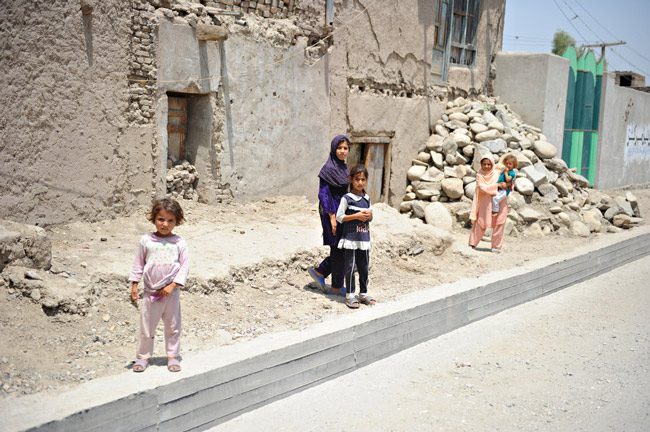
The New York Times this morning runs one of the more fascinating stories you’ll read this week. It’s about Shirin Gul, a Scarface of a woman serving a life sentence in prison for the serial murder of 27 men. Nothing unusual there. The twist, one of many, is that her 11-year-old daughter Meena has been serving the sentence along with her even though she’s innocent: she was born in prison after her mother conceived her with a guard, supposedly to delay her hanging. It worked. Hamid Karzai, the former Afghan president less known for his humanitarian acts than his corruption, commuted the death sentence to life.
 One of the many perversions of Afghan law, which American and NATO troops have been dying to protect for 16 years, allows children to be imprisoned with their mother until they turn 18. There were 36 children at the prison where the Times interviewed Shirin Gul and there are 30 women’s prisons in the country. The math is dispiriting.
One of the many perversions of Afghan law, which American and NATO troops have been dying to protect for 16 years, allows children to be imprisoned with their mother until they turn 18. There were 36 children at the prison where the Times interviewed Shirin Gul and there are 30 women’s prisons in the country. The math is dispiriting.
Meena has never seen a day’s freedom. She doesn’t know what a television is. She’s never ridden in a car. She doesn’t know what it’s like to walk to the store, run beyond sight of walls, scream for the joy of it without being heard, sleep in a bed of her own, a room of her own, have a dream of her own. Coincidentally this weekend—all life is a firmament of coincidences—I’d been reading one of Zola’s duller novels, “The Dream,” about a poor waif, Angélique Marie, who runs away from her brutal foster parents and is given a home by a loving but oppressive couple. To keep her pure and safe they keep her from going to school and limit her movements outside the house to a Sunday walk to church and back, the equivalent of a walk in any prison courtyard. The family’s trade is to manufacture ceremonial clergy cloth, a job Angélique relishes in the workroom that’s also her life.
The difference is that Angélique welcomes her captivity, which Zola wraps into a rosewater fantasy that has her dreaming of the day when a prince marries her when she’s 18. (She does, but dies immediately after her marriage vows, this being Zola.) Probably not much different than the fantasies Meena may be imagining for herself, though Angélique’s story is also wrapped around asphyxiating desire for medieval conceptions of saints and Christianity, a way for Angélique to sublimate her emerging (and, because it’s still Zola, surging) sexuality, incomprehensible to her, into desire for Jesus.
The Times story leaves allegories to another day. It’s more “Notes from Underground.” The realism is all you need to make the point. Meena doesn’t have to fantasize about medieval conceptions of anything. She is living a medieval nightmare, using the word less in its historically Islamic context than in the way Marcellus Wallace means it in “Pulp Fiction,” with more Christian overtones. I doubt actual medieval Islam, reputed for its tolerance and humanity, would have countenanced that sort of imprisonment of innocents. Medieval Christianity, inventor of more torture methods than corrupt cardinals, was another story.
Meena tells Rod Norland, the reporter: “Yes, I wish I could go out. I want to leave here and live outside with my mother, but I won’t leave here without her.” Her mother, a character all her own (she’s all Zola, but the Zola of “Thérèse Raquin” and “The Human Beast”), apparently ridiculed Norland when he asked the girl how she felt in prison. “How do you think she feels?” she told him. “It’s a prison, how should she feel? A prison is a prison, even if it’s heaven.”
But she could let her daughter out. She refuses, making her an accessory. As for her own serial killing, she claims she’s innocent, that she was only an accessory to her boyfriend’s scheme, though she’s reported as “the ringleader.” She was a prostitute, she brought men home, cooked them kababs laced in drugs, and when they keeled over, “her family members robbed, killed and then buried them in the yards of two family homes.” Not the smartest way to dispose of corpses, but Zola’s how-tos (see “Thérèse Raquin”) are not always available in good translations.
Compared to American death rows the Afghan prison looks more like the roomy courtyard of a roadside inn. Inmates mingle. Children mingle. There’s a wall around the prison but not many constraints within, though walls and bars are the last of any constraint. It could be Epcot. If a girl can’t leave, it’s still a prison.
So there goes this 11-year-old girl, one of maybe a thousand, growing up in prison without having ever committed a crime. It’s the law in a country where law is a loose term, itself more of a concept than a plaything in the prisonhouse of religious and tribal customs. I’m all for cultural sensitivity, but not at the expense of human rights, which don’t acquire immunities based on time zone. And we’re there protecting it all why? From whom? Until when?
![]()
Pierre Tristam is FlaglerLive’s editor. @pierretristam.





























Anonymous says
That’s a pretty wild story if true. The children grow up with criminals, so they will learn only criminal ways. I guess the children have a better chance of survival being with their mother than living on the streets with no parent at all. I guess there is no safety net social programs there as there here, to take care of these “prison orphans”. Its not ideal, but it sounds as though it works for them.